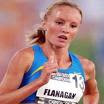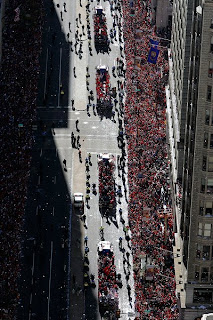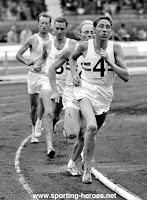Update: Sadly, Dick Patrick, one of the foremost track writers in the country, and a number of other writers were let go by USAToday in December 2009 in a cost cutting move.
In the 1980's, before the internet and blogs, there was no place like
 The USA Today
The USA Today for those interested in the latest track and running news. The national paper's coverage of the sport was top notch from the start-- featuring the top ten finisher listings for
each state for the Boston and New York marathons and the knowledgeable, crisp writing of
Dick Patrick. Twenty two years later the state by state listings are a quaint thing of the past, but luckily for track fans Dick Patrick is still a staple at the paper.
We caught up with Dick after he returned from covering his fifth summer (also 2 winter) Olympics in Beijing for his thoughts on the most recent performance of the USA Track and Field team and the sport in general.
Question: What are your favorite memories covering track and running?
Patrick: There are too many to count or even remember, but I'll give you a couple.
--A recent one: Being in NYC May 31 to see Usain Bolt's first 100 world record. It wasn't so much that it was unexpected, but I was awed by how good he was and how good he could become.
--Seeing Rich Kenah win a bronze medal in the 800 at the 1997 world championships in Athens. I'd known him since his freshman year at Georgetown and saw all his ups and downs while trying to build a post-collegiate career. It was nice to see such a good person and dedicated runner get rewarded.
--London Marathon, 2002. Khalid Khannouchi, Paul Tergat and Haile Gerbrselassie going at it the last six miles or so, the greatest marathoner, cross country runner and track runner of their times. Khalid won in a world record. What made it better was that I helped him connect with the Whartons, who worked their magic on some hamstring and other leg problems he was having.
--Hooking up with Bill Rodgers during a run in Central Park and having a brief conversation before he dropped me. Along with that all the nice visits over the years with runners such as Joan Samuelson, Ingrid Kristiansen, Grete Waitz, Kim Jones, Khalid, Billy, Frank Shorter, Steve Holman, Kenah, Pat Porter, Juma Ikangaa, Steve Jones, Arturo Barrios, Alan Webb. I know I'm leaving a lot of people out -- how could I forget Deena Kastor, Meb Keflezighi, Eamonn Coghlan, John Treacy and Bob Kennedy -- but you get the idea.
--A trip to Kenya in 1998. Spent several days in the Rift Valley and came home with a sense of how the land and lifestyle shape the runners and how much talent exists there.
Question: Do you think we are in a distance running resurgence in the USA?
Patrick: I see positive signs. In recent years sometimes we had trouble finding three guys with the A standard in the 1,500. This year we left some good people home, including Webb. Bernard Lagat has had an incredible career and raised the bar for U.S. runners. I think Ryan Hall can so some great things in the marathon. It's important for the young kids to see veterans having success so there's optimism and enthusiasm among the emerging elites.
Question: In general do you think there is less coverage from the US media for track and running than there was?
Patrick: Unfortunately that's true at least in the mainstream media. What will be interesting to observe is how niche websites such as letsrun.com will affect the sport. Still you need TV and newspaper coverage. We have to find a way to turn all the kids participating in track and cross country (over 1 million and 411,00 respectively this year) into fans of the sport.
Question: Was that diminshing coverage a factor or a by product for a period of less competitive US runners?
Patrick: Partly. I think the biggest reason goes back decades when track didn't adapt to the changes in sports marketing and television and got left behind by pro football and other major sports. It always helps coverage to have a superstar. It was easy to talk editors into coverage when Bill Rodgers was winning Boston and New York. The best thing to happen to the sport now would be to have a homegrown middle-distance star. An Alan Webb or someone who could beat the Africans and Europeans regularly and win medals would energize coverage.
Question: Do you think there would be enough interest in a major summer meet in the US before or after the European circuit?
Patrick: That's being talked about now. We have Prefontaine, before the Euro circuit gets going. Eugene did a wonderful job at the Trials and may lobby to make the Pre meet part of the Golden League.
I've seen European meet promoters gush at the site of the Penn Relays. However, I think that if you tried to stage a major meet in Philly the crowd would be lousy. The Penn Relays are as much a cultural event, heavy on the Jamaican influence, as a track meet.
(The famed Penn Relays gets 100,000 spectators in Franklin Field in April and was mentioned as a possible location.)
Question: Can you tell us about your, family and interests, hobbies etc.?
Patrick: I've been a track fan for as long as I can remember. My mother's side of the family was into the sport. I had a cousin who was the captain of the track team at Notre Dame and then was a high school coach in NJ for close to 40 years -- he coached 1968 400 medalist Ron Freeman and Ed Grant (legendary NJ track correspondent) loves him. We used to spend summer vacations at this beach house when I was a kid. I was captivated by the old issues of Track & Field News and all the track equipment around the house.
I ran in high school but with no distinction. Then I started running again in the mid-70s, shortly before I started journalism in 1975. It's been my fortune that at every paper where I've worked nobody else was interested in track or road running. I was only too happy to fill the void. I have gone around the world covering a sport that I love. My only disappointments are my own running -- on hold for a few years now because of a left leg that goes numb 5 minutes into a run -- and the fact that the newspaper industry is going through tough times.
Question: Finally how you became interested in track?
Patrick: I was born in Baltimore in 1950, moved to Upstate NY at 10 and to Louisville, Ky., at 13. I was a track junkie by 10. My uncle the priest took me to my first Millrose Games in the '60s. In 1987 he accompanied me to the World Championships in Rome and said mass with the pope.
Question: By being in Beijing you missed the television (NBC) coverage of track-- plenty of beach volley ball but track was hard to find and almost seemed to be an after-thought and not the centerpiece this year. As a coach we counted on the "bounce" of track coverage every four years to get kids out-- we may not get it this year, thoughts?
Patrick: Your complaints about the NBC coverage echo those of my friends and family. I have an uncle, an 89 year old priest who long ago made me a track fan, and he was fed up when I called him a couple of times from the Bird's Nest. He was tired of beach volleyball and frustrated the track coverage was on so late.
I have seen a couple of items about swimming getting a bounce from Phelps. I think track might have to hope that Alan Webb hits it big some day-- maybe

that would encourage/motivate kids in the middle distances. By the way, Webb's high school is about 10 miles from our office and I've been watching him race and train for several years now. His high school workouts were incredible-- he already had a professional approach and discipline.
A quick story: On his graduation day , which came when he was still wiped out following his 3:53 mile, he cut his workout short-- a good decision by him and his coach, reading his body. As he was finishing his warmdown, he remembered it was a day he was supposed to do his hurdle drills. The hurdles weren't on the track so he had to drag them out of the shed, set them up and go through the

routine. After he put the hurdles back in the shed, he also realized he should ice his legs. We finished the interview in the training room with him waist deep in a trash can of water and ice. Then he went off to graduation a couple of hours later. Not many kids would have had that kind of discipline and attention to detail. (Those qualities are why I haven't give up on him yet.)
Question: This was hailed before the games as the greatest US Track and Field Team since 1968 but the overall performances seemed to be disappointing-- thoughts?
Patrick: As far as disappointments, I don't think there is any unform explanation. Ther more I see at this level-- this was my fifth summer Games-- the more I realize that chance and bad luck can override careful planning. Several US athletes who went to the training camp in Dalian wound up getting

sick. Flanagan (bronze medal winner in 10k) wasn't even sure she'd be able to enter the 10k because of gastro-intestinal problems. I think her performance , a U.S. record in those conditions, has been overlooked. I think she was wiped out for the 5k later. If she's 100%, I think she would have been more in the mix for that race.
Dick shared some other observations on the Olympics:
--Allyson Felix wasn't the athlete she's been the last couple of years. I wonder if excess travel might have hurt her. After the trials, she made two round-trips to Europe before going to Beijing. She ran a couple of races on the circuit and returned for a friend's wedding. Then she went back and had a couple sub-par races. She probably should have bagged the second trip.
--Not sure what happened to Sanya Richards. She says her right ham cramped with about 80 to go. Michael Johnson discounts that and says she ran too tight and too hard the first 200 and then paid the price coming home.
--Tyson Gay had bad luck. He just didn't have enough time after the Trials to heal the hamstring. Not that it would have made a difference in the winner -- Bolt is just too good. (I hope he's clean.). Walter Dix had a good meet. He had a hamstring injury in April and was fourth in the NCAA 100. Then he manages two bronzes. I think that Trials/Olympics double is tough for our sprinters. Bolt didn't have eight Trials rounds in his legs before China.
--Another ill-timed injury was Adam Nelson pulling an intercostal muscle a few days before the shot. You make a point that might apply to those guys. The competition to make the U.S. team is so tough that it's tough to peak again a few weeks later for the Olympics. None of the three U.S. guys performed well.
--Jeremy Wariner's race was a disappointment. I still think he made a mistake in leaving Clyde Hart.
--Bernard Lagat seemed another ill-timed injury victim, though this year he has never seemed as strong as he was last year when he did the 1,500-5,000 double at worlds. After the U.S. trials, he followed his usual plan and went to Germany, his headquarters during the Euro season. But he had left Achilles problems that hampered his training. On top of that he came down with a sore throat/respiratory problems in Beijing.
Last year I felt he had an answer for any type of strategy -- hard from the gun or sit and kick. This year I never sensed he had the strength or speed of last year.
--Lolo Jones. What a heartbreak. Not sure what happened in her race. She may have had the thought "I can win an Olympic gold" that distracted her just enough to hit the ninth hurdle. Or maybe she was running so fast she just didn't have enough time to get that lead leg up.
--Don't know what to say about the 4x100s. We've tried to address some of the problems of the past but it doesn't seem to make any difference. But two dropped sticks on the anchor leg was tough to watch.
With all of these disappointments, there might be some teaching points for your runners. For the most part, those disappointed athletes were extremely classy, particularly Jones, Lagat, Nelson, Gay, Felix and Richards. At their lowest moment and under a lot of pressure, they maintained their poise and sportsmanship. I was impressed.
Thanks Dick for your time and for all the years of great coverage!


 that must be minimized but not avoided. Or else you come to the starting line completely flat. But you can get too much of that peculiar empty feeling-the tightness in the stomach, the urge to yawn. The answer is enough adrenalin but not too much.
that must be minimized but not avoided. Or else you come to the starting line completely flat. But you can get too much of that peculiar empty feeling-the tightness in the stomach, the urge to yawn. The answer is enough adrenalin but not too much.  that must be minimized but not avoided. Or else you come to the starting line completely flat. But you can get too much of that peculiar empty feeling-the tightness in the stomach, the urge to yawn. The answer is enough adrenalin but not too much.
that must be minimized but not avoided. Or else you come to the starting line completely flat. But you can get too much of that peculiar empty feeling-the tightness in the stomach, the urge to yawn. The answer is enough adrenalin but not too much. 













































